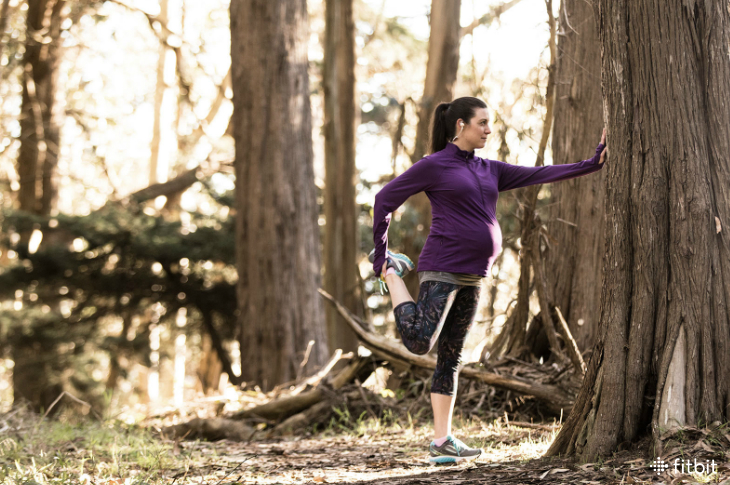
Not so long ago, women were told to take it easy during pregnancy to avoid harming themselves and the baby. Fortunately, that advice has evolved as research continues to show the very real benefits of being physically active during all three trimesters.
In fact, studies show that exercise may help reduce the risk of miscarriage, cesarean section, pre-term birth, preeclampsia, gestational diabetes, and excessive weight gain. Just how it works isn’t clearly understood, but Linda May, PhD, an exercise researcher at East Carolina University, says it may be a combination of exercise-induced anti-inflammatory and antioxidant factors, as well as the release of certain hormones.
May’s research further shows that moms-to-be who exercise have a lower resting heart rate, as well as increased heart rate variability—a sign of a healthier heart. “Based on the ultrasound, we’ve seen increased heart function benefit the children, too.”
In 2015, the American College of Obstetrics and Gynecologists (ACOG) updated its guidelines to reflect some of the more recent research. ACOG now recommends that pregnant women get at least 150 minutes of moderate-intensity exercise per week, or 20 to 30 minutes each day.
Even still, active women should be aware of what is and isn’t safe during each stage of their pregnancy. Check out the trimester-by-trimester breakdown below. And remember: Always check with your healthcare provider before engaging in physical activity.
Prenatal Exercises For Each Trimester
1st Trimester
Most women don’t need to modify their activities too much during the first three months, says May. “If you’ve been active, continue doing what you’re doing,” she says. “The baby is going to benefit from it.” If you run, keep running. The same goes for swimming, walking, stationary biking, weight lifting—it’s all good.
If you haven’t been active, now is actually the perfect time to begin, says May. You’ll just want to start slow and work your way into exercise, much as you would if you weren’t pregnant. “You might start at 15 minutes and work up to 30 minutes each day,” she adds.
That said, a few activities should be avoided while pregnant:
- Any activity that might cause you to fall (road cycling, skiing, gymnastics)
- Contact sports (soccer, basketball)
- Scuba diving
- Skydiving
- Hot yoga or hot Pilates, due to the risk for overheating
2nd Trimester
This is about the time you’ll start to notice a “belly bump,” if you haven’t already. It’s also when you’ll need to cease doing any exercise that requires you to lie on your stomach or your back. Doing so could compress the inferior vena cava, the large vein that carries deoxygenated blood back to your heart, says May. That precludes many floor exercises—though you can still do ones that require you to lie on your side, like clam shells or leg lifts.
Weight training is fine, though machines are better than free weights, since they control the movement. Resistance bands are also great. While doctors used to believe that pregnant women should not raise their heart rate above 140 beats per minute (bpm), more recent research suggests that exceeding 140 bpm is fine, depending on the woman’s age and fitness level. If you own a Fitbit Alta HR, Fitbit Charge 2, Fitbit Versa, or Fitbit Ionic, your device comes with PurePulse technology, which continuously monitors your heart rate and helps generate real-time heart rate zones so you can personally tailor your workouts.
Indeed, ACOG’s guidelines note that 30 minutes of strenuous activity is well tolerated by pregnant women and their babies during the second trimester if they’ve been active.
3rd Trimester
Chances are your belly is big enough that you can’t do a plank without resting your stomach on the ground. But even if it’s not, no planks, says May. And you may need to adjust other exercises as well to accommodate your growing belly. Instead of doing push-ups off the floor, try wall push-ups for an easier angle. You might also find yourself using a wider stance on squats. Remember, there’s no shame in lightening the load either. Modify biceps curls and lateral raises with light, three- to five-pound dumbbells to keep your arms toned and get you ready to start carrying your new baby.
“Otherwise, pretty much what’s safe at the beginning is safe at the end,” says May. Just choose activities that feel good to you since you’re more likely to stick with them as you progress through your pregnancy. “I’m a big proponent of doing what you enjoy,” says May. “If you feel more comfortable in the water, then swim or do water aerobics. If you feel more comfortable walking outside, then walk outside.”
This information is for educational purposes only and is not intended as a substitute for medical diagnosis or treatment. You should not use this information to diagnose or treat a health problem or condition. Always check with your doctor before changing your diet, altering your sleep habits, taking supplements, or starting a new fitness routine.

If you have questions about a Fitbit tracker, product availability, or the status of your order, contact our Support Team or search the Fitbit Community for answers.
Please note: Comments are moderated and may not appear immediately after submission.